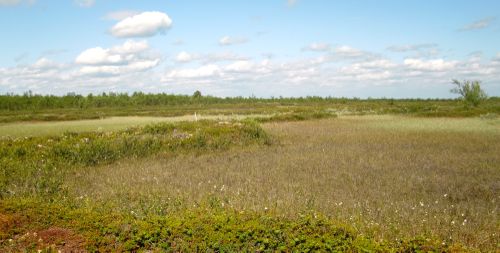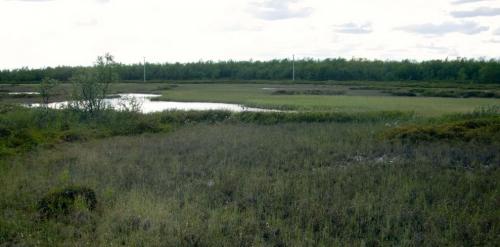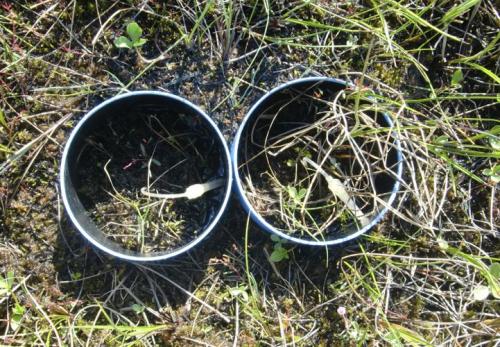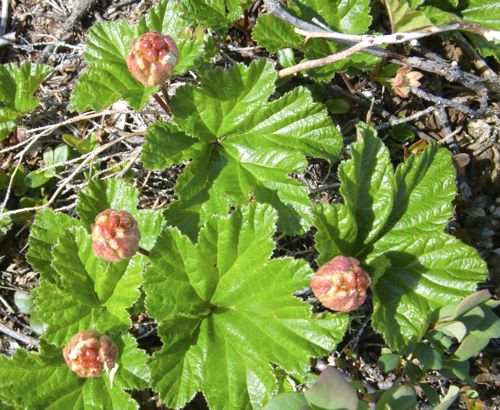The gas measurements we have been doing since I arrived are providing the control gas fluxes for Kim's experiment. Later in the summer, Kim will be adding chemicals to half of the collars, in an effort to gain more insight into what controls methane flux in Arctic wetlands.
Arctic Wetland Topography
An Arctic wetland is by no means homogenous or static. Petsikko can be called a patterned mire. It contains depressions that are very wet, and raised areas that are relatively dry and so support different vegetation.

The raised areas are due to ice wedges that have formed in the soil beneath. Remember that when water freezes it expands, lifting the soil above it. As the ice wedge grows, the area above continues to lift. More vegetation grows on the lifted area, as it becomes a warmer, drier microenvironment.
As these areas rise over time, the land between them may become a depression. If it does, the depression will often collect available water.
However the ice wedges are not stable. Slightly warmer conditions on either side of a wedge could cause it to melt. The water in the depression is slightly warmer than the ice itself. If the ice wedge melts, the raised area will collapse, and water from the surrounding area will flow in, causing the once-raised area to become a much wetter depression. When you look at Petsikko closely, you will see that there are different levels to the various depressions. The differing levels contribute to the ease with which one depression will drain into another when ice wedges melt.

The vegetation the once-raised area supported now becomes dead organic material at the bottom of a depression. With the submersion, the organic matter not only becomes anoxic, but may also come in contact with minerals that often lie above bedrock. Therefore, the availability of different electron acceptors (remember the oxidation/reduction process of soil microbe cellular respiration) for soil microbes may change greatly over time as the wetland system changes.
Iron Pockets
Kim's experiment is designed to create different chemical conditions for the soil microbes, as if the dead organic matter (with its soil microbe community) has come into contact with additional iron (perhaps as a result of changing wetland conditions). She uses iron, as this is an abundant mineral in the earth's crust.
Kim will add a solution of Fe(III) to one collar in each pair of collars, and an equal amount of water to the other of the pair. The amount of iron added is approximately equal to the amount of iron that would be introduced to the system if a rusty nail were dropped into the collar. She will then resume analyzing the gases emitted from the collars for carbon dioxide and methane.

In Summary…
Currently the amount of water in the soil (soil moisture) and the soil temperature are the two environmental variables that are used to predict how much methane an area will emit. We already know that the wetter the soils in an area (meaning there will be less oxygen for the microbes), and the warmer the soils in the area, the more methane will be produced. Kim is working to examine how another environmental variable – soil chemistry – might also be affecting the soil microbial populations that produce the greenhouse gases carbon dioxide and methane.
In her work in Barrow, Alaska, Kim has run a similar soil chemistry experiment. She found that, in the 5-week time she was able to run the experiment, changing the soil chemistry by adding alternative electron acceptors like iron did suppress the methane emissions.
Field Day Bonus:
We saw actual cloudberries developing! Cloudberries are considered a delicacy in every northern environment in which I have visited, lived or worked (Alaska, Newfoundland, Norway, and now Finland). Their July ripening is eagerly anticipated. However, it is only mid-June! These rapidly growing berries are testament to the heat wave that northern Finland has been experiencing. I saw the cloudberry flowers bloom not too long ago. Kim is going to have a bonanza crop to harvest in a short while!



Comments